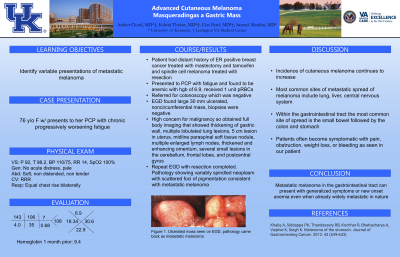Sunday Poster Session
Category: Stomach
P1403 - Advanced Cutaneous Melanoma Masquerading as a Gastric Mass: A Challenging Diagnostic Case Report
Sunday, October 22, 2023
3:30 PM - 7:00 PM PT
Location: Exhibit Hall


Amber Cloud, MD
University of Kentucky
Lexington, KY
Presenting Author(s)
Amber Cloud, MD, Kshitij Thakur, MD, MSc, Ujas Patel, MD, Samuel Mardini, MD, MBA, MPH
University of Kentucky, Lexington, KY
Introduction: We present a case of a patient with a bleeding gastric mass that was found to be advanced cutaneous melanoma.
Case Description/Methods: 76 year old female with distant history of ER positive breast cancer and spindle cell melanoma presented to her outpatient primary care doctor with worsening fatigue. She was subsequently found to be acutely anemic requiring transfusion. Colonoscopy was performed and was largely unremarkable. EGD was performed and showed a large 30mm ulcerated, noncircumferential mass. Biopsies were taken and pathology from those came back as hyperplastic gastric polyp with focal surface erosion and reactive epithelial changes without metaplasia, dysplasia, malignancy.
She was referred to surgical oncology who obtained full body imaging due to high concern for malignancy in the stomach even with negative biopsies. CT of the abdomen and pelvis showed thickening of the gastric wall with evidence of the 2 cm mass. Multiple lesions all concerning for malignancy were observed including multiple lobulated lung lesions, a 5cm lesion in the uterus, midline paraspinal soft tissue nodule, multiple concerning lymph nodes along with small enhancing foci in the omentum concerning for peritoneal carcinomatosis. An MRI head was then obtained which showed several small lesions scattered in the cerebellum, frontal lobes, and postcentral gyrus all concerning for metastatic disease. Patient went back for repeat EGD for tissue sampling and resection and the ulcerated mass was visualized with a central depression and overlying hematin. The lesion was resected and pathology resulted showing variably spindled neoplasm with scattered foci of pigmentation consistent with metastatic involvement by melanoma.
Discussion: The incidence of cutaneous melanoma continues to increase. Metastatic disease can affect any organ with the lung, liver, and central nervous system being the most common sites of spread. Within the gastrointestinal tract the most common site of spread is the small bowel followed by the colon and the stomach. These patients often present after becoming symptomatic due to their disease with most common presenting symptoms being pain, obstruction, bleeding, weight loss. Treatment modalities continue to advance with positive outcomes being seen with immune checkpoint inhibitors.
Disclosures:
Amber Cloud, MD, Kshitij Thakur, MD, MSc, Ujas Patel, MD, Samuel Mardini, MD, MBA, MPH. P1403 - Advanced Cutaneous Melanoma Masquerading as a Gastric Mass: A Challenging Diagnostic Case Report, ACG 2023 Annual Scientific Meeting Abstracts. Vancouver, BC, Canada: American College of Gastroenterology.
University of Kentucky, Lexington, KY
Introduction: We present a case of a patient with a bleeding gastric mass that was found to be advanced cutaneous melanoma.
Case Description/Methods: 76 year old female with distant history of ER positive breast cancer and spindle cell melanoma presented to her outpatient primary care doctor with worsening fatigue. She was subsequently found to be acutely anemic requiring transfusion. Colonoscopy was performed and was largely unremarkable. EGD was performed and showed a large 30mm ulcerated, noncircumferential mass. Biopsies were taken and pathology from those came back as hyperplastic gastric polyp with focal surface erosion and reactive epithelial changes without metaplasia, dysplasia, malignancy.
She was referred to surgical oncology who obtained full body imaging due to high concern for malignancy in the stomach even with negative biopsies. CT of the abdomen and pelvis showed thickening of the gastric wall with evidence of the 2 cm mass. Multiple lesions all concerning for malignancy were observed including multiple lobulated lung lesions, a 5cm lesion in the uterus, midline paraspinal soft tissue nodule, multiple concerning lymph nodes along with small enhancing foci in the omentum concerning for peritoneal carcinomatosis. An MRI head was then obtained which showed several small lesions scattered in the cerebellum, frontal lobes, and postcentral gyrus all concerning for metastatic disease. Patient went back for repeat EGD for tissue sampling and resection and the ulcerated mass was visualized with a central depression and overlying hematin. The lesion was resected and pathology resulted showing variably spindled neoplasm with scattered foci of pigmentation consistent with metastatic involvement by melanoma.
Discussion: The incidence of cutaneous melanoma continues to increase. Metastatic disease can affect any organ with the lung, liver, and central nervous system being the most common sites of spread. Within the gastrointestinal tract the most common site of spread is the small bowel followed by the colon and the stomach. These patients often present after becoming symptomatic due to their disease with most common presenting symptoms being pain, obstruction, bleeding, weight loss. Treatment modalities continue to advance with positive outcomes being seen with immune checkpoint inhibitors.
Disclosures:
Amber Cloud indicated no relevant financial relationships.
Kshitij Thakur indicated no relevant financial relationships.
Ujas Patel indicated no relevant financial relationships.
Samuel Mardini indicated no relevant financial relationships.
Amber Cloud, MD, Kshitij Thakur, MD, MSc, Ujas Patel, MD, Samuel Mardini, MD, MBA, MPH. P1403 - Advanced Cutaneous Melanoma Masquerading as a Gastric Mass: A Challenging Diagnostic Case Report, ACG 2023 Annual Scientific Meeting Abstracts. Vancouver, BC, Canada: American College of Gastroenterology.
